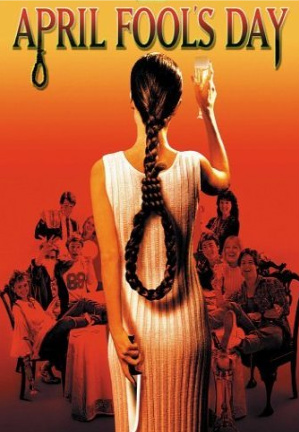
April Fool’s Day was released in 1986 as the slasher genre was gasping its final breaths. From then on the few remaining offerings would consist of ever-decreasing sequels and straight-to-video atrocities. The Friday the 13th and Halloween formulas had worn thin and even those franchises had jettisoned their resident boogeyman in favour of new storylines. A Nightmare on Elm Street had offered fans something new, yet its sequel had failed to generate the same kind of excitement, resulting in the slasher being written off as a has-been. All that remained were a few obscure offerings (Slaughter High, Nail Gun Massacre, Killer Party) that failed to generate much attention beyond its core audience. With the future of its Friday the 13th series uncertain, Paramount Pictures instead opted to try a new approach, one that would not only poke fun at the genre it had help to popularise but also help reinvent it as a postmodern thriller for young adults.
The project was first conceived by Frank Mancuso Jr., whose father had been the head of the studio and had begun to carve a successful producing career himself after starting out at the bottom on the 1981 slasher Friday the 13th Part 2. Over the years he had slowly built a reputation as he had nursed the franchise through several profitable sequels, before 1985’s Friday the 13th Part V: A New Beginning had brought the series to a standstill. Unsure of which direction to take next, he instead chose to satirise the films which had brought him so much success by producing a playful homage to the slice ‘n’ dice flicks of the eighties. Looking for a suitable premise, Mancuso Jr. was approached by screenwriter Danilo Bach – fresh from his Academy nomination for Beverly Hills Cop – who had read an article in a Maine newspaper about a mystery weekend and had felt it would make a suitable horror. Bach was sent to Paramount to pitch his suggestions to a board of executives, with his initial treatment taking a cue from Agatha Christie’s detective novel And Then There Were None, as well as Mario Bava’s Reazione a catena (aka Twitch of the Death Nerve, which Friday the 13th Part 2 had been accused of plagiarising).
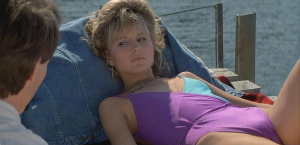
The film opens with a selection of home video footage of a group of friends who prepare to venture out to a island for a weekend of typical teenage debauchery, with one girl boasting to “fuck on the first date.” The aforementioned island is owned by Muffy St. John (Deborah Foreman), their classmate and recent beneficiary of the estate, who has invited the group under false pretence. The friends – including Kit Graham (Amy Steel), Chaz Vyshinski (Clayton Rohner), Arch Cummings (Thomas F. Wilson) and Harvey ‘Hal’ Edison (Jay Baker) – board a ferry and set sail to the retreat, but during the trip Arch throws accidentally throws a knife which lands in Skip St. John (Griffin O’Neal)’s stomach, causing him to collapse into the water. After jumping into the water to save him, they discover that it was an elaborate practical joke (it is worth noting at this point that Skip is Muffy’s cousin), but tragedy strikes as when they dock one of their deckhands, Buck (Mike Nomad), is crushed by the boat, resulting in him losing an eye and being rushed back to the mainland.
A cop (Tom Heaton), who was witness to the incident, insists that they remain on the island so he can find them for further questions, and so they head to Muffy’s luxurious summer home. The jokes begin that evening during a meal, when a series of cheap whoopee cushions are followed by chairs which fall backwards, sending the guest harmlessly to the floor. Further pranks are employed throughout the night in an effort to unnerve the friends, including creepy eyes peering through a portrait and a the noise of a crying baby in a closet. Various artefacts from each of their pasts also appear, which they assume is another cruel joke from their host. That night, Skip disappears and the following morning Kit and her lover, Rob (Ken Olandt), claim to see his corpse as they were making out, and so the group head out into the wilderness to find him. One-by-one, in typical slasher fashion, the friends begin to disappear, with the suspicion eventually turning to Muffy. But it is finally revealed that the entire weekend – from Buck’s accident to the deaths of each of the friends at the hands of Muffy’s psychotic twin sister, Buffy – was one huge practical joke, with the lone survivor (and thus the viewer) being the victim of the prank. The final twist being that the weekend was a test by Muffy and her accomplices for an adventure weekend she was hoping to turn the island into.
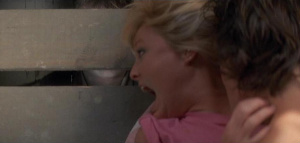
Blending elements of whodunnit, teen comedy and slasher, April Fool’s Day marked a return to the genre by director Fred Walton, who had previously helmed the 1979 thriller When a Stranger Calls. The cast, pooled together by New York-based Pamela Basker and Fern Champion (who had previously cast Fade to Black, The Funhouse and two Friday the 13th movies) consisted of various rising young stars of the eighties, including Friday the 13th Part 2‘s Steel (hired at Mancuso Jr.’s recommendation) – one again playing another final girl, Kit – Back to the Future‘s Wilson (who would play the resident practical joker) as Arch, Hill Street Blues‘ Rohner and Foreman – who portrays the dual roles of Muffy and Buffy with a sadistic glee – who would later appear in Anthony Hickox’s equally tongue-in-cheek Waxwork. The remaining roles would be filled by Pat Barlow, Deborah Goodrich, Olandt and stuntman Mike Nomad (Splash/Friday the 13th Part VI: Jason Lives), whose brief appearance as Buck would consist of a dangerous stunt where he would disappear under the boat/jetty.
The crew also consisted of a selection of talented individuals. The lush cinematography was handled by Charles Minsky, who would later find acclaim with the likes of Pretty Woman, the 2005 remake of The Producers and You, Me and Dupree. The playful score was composed and performed by Charles Bernstein, previously known for his work on The Entity, Cujo and A Nightmare on Elm Street, whilst the film was cut by Bruce Green, who had worked as an assistant editor on Raiders of the Lost Ark and Indiana Jones and the Temple of Doom. Despite the special effects being few and far between, the chores were handled by the always reliable Martin Becker, co-founder of Reel EFX (which he formed alongside David Lopez) and hired due to his long association with Paramount on the likes of Star Trek: The Wrath of Khan and Friday the 13th Part 3.
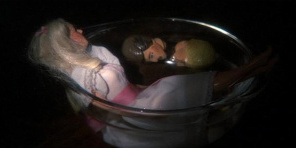
Walton once again proved what a talented filmmaker he is with his slow burning and playful pace, utilising the various gimmicks and set pieces laid out in Bach’s self-referential script. There are various in jokes included, such as a mention to Agatha Christie and the Happy Birthday to Me-style twist of a twin sister being the true killer. The actors, too, are well aware of what kind of movie they are taking part in and have fun running with the joke, especially Wilson, who plays less of a villain than he did in Back to the Future. Steel creates another impressive final girl, not quite as pro-active as Friday the 13th Part 2‘s Ginny Field but a likeable heroine all the same. But the star of the show without a doubt is Foreman, who hams it up in the dual role Muffy and her imaginary sister. It is such a shame that she did not receive more recognition for her work as she was clearly a talented actress but failed to find her perfect role. An interest footnote regarding O’Neal (who was the son of legendary actor Ryan O’Neal) was that the following year he would be indicted under the charge of manslaughter when, on May 26 1986, he had caused his boat to crash whilst under the influence of narcotics, which resulted in the death of Gian-Carlo Coppola (son of filmmaker Francis Ford Coppola, whom O’Neal had been working with on Gardens of Stone). Twenty-three year old Coppola’s fiancée, Jacqui de la Fontaine, was two months pregnant at the time of the incident.
Many slasher fans have heavily criticised April Fool’s Day due to its twist ending, which would reveal that no characters had actually died, making it one of the most tame entries of the genre. This is a minor criticism, though, as the filmmakers’ attempts to try something new with the formula mostly succeed. Bach’s understanding of the formula adds a playful tone to the proceedings and Walton’s direction is assured and faithful to the films it references. The cast are mostly likeable and the dialogue tongue-in-cheek. As a precursor to Scream, April Fool’s Day is an ingenious addition to the genre, but its lack of bloodshed alienates many fans. But for those who tire of the usual blood and T&A that often populated the eighties, April Fool’s Day is a welcome retreat that may not have resurrected the slasher like fans had hoped but was at least a fun and inventive alternative.
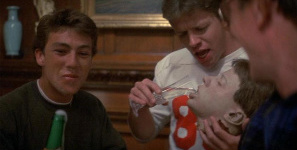

19 Responses to April Fool’s Day (1986)